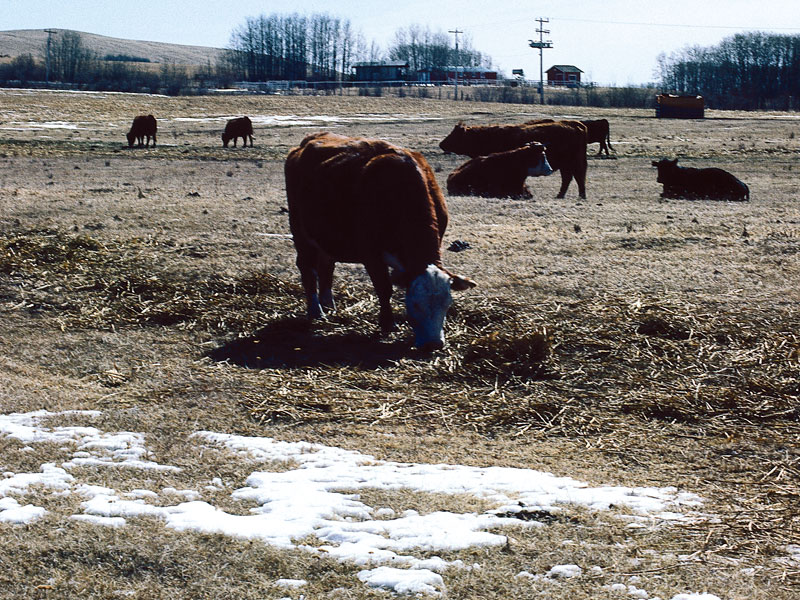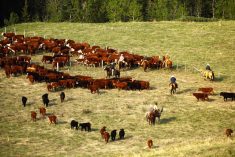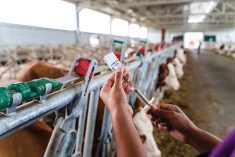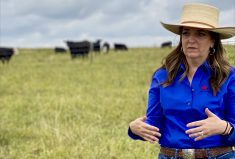Despite the ongoing bovine tuberculosis situation in southeastern Alberta, many producers may not know some basic facts about the disease.

“Bovine TB is caused by bacteria. Many types of mycobacteria exist, and many types of mycobacteria bovis exist,” Karin Schmid, beef production specialist with Alberta Beef Producers, said during a recent Beef Cattle Research Council webinar.
There are many types of mycobacterium bovis. One can also cause Johne’s disease in cattle and another can cause TB in humans.
Bovine tuberculosis is infectious, but not overly so.
“It requires frequent and extended nose-to-nose contact or contact with bodily secretions over an extended period of time,” said Schmid, the industry liaison for the western area emergency centre for the current tuberculosis investigation since last November
Read Also

Horns aren’t unlocking anytime soon on livestock transport standards
Standards good enough meet the definition of “humane” animal transportation still vary widely between what what industry wants, what animal rights advocates want and, between the two, what federal regulators decide is good enough.
The bacteria are sensitive to heat and sunlight, as well as dry conditions. Mycobacteria bovis is hardy and does well in cold and moist conditions. It can cause a slow, progressive disease in cattle.
Even though its preferred host is cattle, mycobacteria bovis can affect a wide variety of warm-blooded mammals. The disease causes lesions in the lungs as the body tries to wall off the infections, and the bacteria spreads throughout the blood and lymphatic system. The disease can lie dormant until the immune system breaks down.
“It is a sneaky bug. It is basically a bacterial ninja. It can hide in the body until something causes it to become active and lesions develop,” said Schmid.
Cattle will not show any outward clinical signs until the disease is far advanced.
“You won’t be able to look at an animal and see if it has TB,” she said.
Once the disease advances, an animal may lose its appetite and lose weight or exhibit a fluctuating fever. If their lungs are severely diseased, they may have a chronic cough.
Bovine TB is a reportable disease in Canada, and there are eradication and surveillance programs in place as Canada’s status as a TB-free country is important for international trade.
“Our surveillance relies on surveillance at slaughter. Ninety-five per cent of cattle are slaughtered at federal plants,” said Schmid.
Slaughtered cattle are inspected for lesions consistent with tuberculosis. (Many different diseases cause lesions.) Before the case found in Jenner last year, the last Canadian case was in B.C. in 2011.
Canada’s eradication program began in 1923 and full herd depopulations were implemented in 1978. Canada was declared tuberculosis free by the World Organization for Animal Health in 1985 and is statistically free from tuberculosis (which means that 99.90 per cent of cattle and 99.8 per cent of herds are free of the disease). For the tuberculosis-free status to be affected, two unrelated cases need to occur in the same general area.
When positive cases are found, authorities move into the eradication mode. The process includes a quarantine, an epidemiological investigation, screening, and confirmatory tests. It also means tracing, with animal movements tracked for five years in accordance with international guidelines. Those involved in the investigation track herds that have had direct or fenceline contact with infected animals, trace-outs (animals purchased from an infected herd), and trace-ins (animals that have come into the infected herd from another source).
“Animal records and knowing where cows are at any given time, and knowing which cows went where could be really important in a disease investigation,” said Schmid.
Proper animal records can reduce testing and depopulation.
“Record-keeping is extremely important. Epidemiology also helps us determine the animals with the most risk, and move down to the animals with the least risk,” she said.
The riskiest groups are dealt with first. These include the herds with the confirmed positives, followed by any animals that had direct contact with the infected herds, and fenceline contacts.
There are a variety of live tests for animals at risk, including blood tests.
















